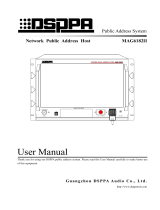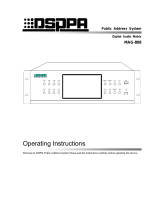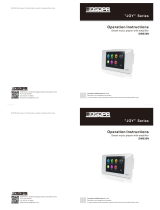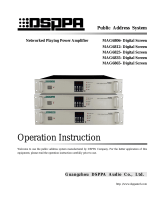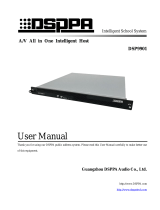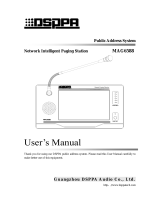Page is loading ...

1
Public Address System
Micro Intelligent Public Address System
MAG2120II
MAG2140II
User’s Manual
Thank you for using DSPPA public address system. To ensure optimal operation of this equipment, please read these
operational instructions carefully before using.
Guangzhou DSPPA Audio Co.Ltd
http://www.DSPPA.com
http://www.dsppstech.com

2
Information on Operation Instructions
This Operation Instructions involves MAG2120II and MAG2140II micro intelligent systems for
public address system, including function introduction and appearance introduction of products,
connection illustrations, settings, operation instructions, precautions, after-sale services, product
performance and specifications. Please read this Operation Instructions carefully before connection
and operation.
All contents in this Operation Instructions are based on operation of MAG2140II, which are only
for illustration. Furthermore, operation methods for MAG2120II are similar to that of MAG2140II.
For future use, please make a good disposition of this manual

3
Content
1. System Overview ............................................................................................................................................................................ 4
2、Performance characteristics .......................................................................................................................................................... 4
3、Appearance and Functions ............................................................................................................................................................ 5
4、Connection Description ................................................................................................................................................................ 8
5、Operation Instructions ..................................................................................................................................................................12
6、 Other Functions ..........................................................................................................................................................................31
Packing list .........................................................................................................................................................................................34
Specifications .....................................................................................................................................................................................36
1 Safety Precautions ...........................................................................................................................................................................37
2. Precautions for After-sale Services ............................................................................................................................................38
ATTACHMENT ................................................................................................................................................................................39
Remote Control (Optional) ................................................................................................................................................................40

4
1. System Overview
Micro intelligent public address system integrates such functions as playing, intelligent timing control, audio matrix,
partition control, intelligent firefighting linkage, remote computer control as well as telephone and remote paging.
Owing to its integral public address functions and individualized intelligent control functions, this address system can
better satisfy demands of users of medium and small address systems, such as amplification at such public places as
primary and high schools, medium and small plants, parks and square.
This address system falls into two types as per the number of control zone, namely MAG2120II and MAG2140II.
MAG2120II and MAG2140II can control 20 and 40 zones respectively to provide more options for users.
2、Performance characteristics
1. A public address controller integrating has such functions as playing, intelligent timing control, audio matrix and
partition control.
2. It has 5 timing programs. Each timing program is provided with 500 timing points for 7-day circulation. Each timing
point is available for control of audio source selection, bell, built-in MP3, AM/FM, 2-way power source, 4 types of
external peripheral audio sources (CD, tuner, socket and MP3 program player). The 5 timing programs are easy for
switch-over.
3. 8-route common audio source input, built-in MP3, AM/FM, 1-route local aviation microphone input 1
st
prior
function), 1-route alarm signal input (2
nd
prior function), 1-route remote paging microphone signal input (3
rd
prior
function) and 40-route output large audio matrix.
4. 40-route emergency firefighting input (short-circuit signal), 1-route firefighting linkage output (short-circuit signal
used for expansion, which is available for connection with MP99/8815E, MP99/8823S and so on) (each route of
emergency input is available for triggering of any programmable and random zone)
5. It is available for connection with external computers through LAN interface for control of the host computer via
software (realize auto play as per fixed time, location and program through remote setting). (Such function is to be
realized by remote control software as purchased separately)
6. It is available for expansion of remote paging microphone through 9 pin ports.
7. All timing programs are available for instantaneous and easy manual intervention.
8. It is available for real-time monitoring of each zone and volume control (mechanical volume control).
9. It is equipped with ARM9 platform and 5.6-inch color screen + touch pad.
10. It is provided with USB interface used to copy songs in the USB directly to the host computer for play.
11. It can realize 100m wireless remote control with 12 programmable buttons. It can realize customized on/off of zone
and selection of audio source and songs with one button.
12. It is provided with 3 types of bell signal output functions (mechanical volume control).
13. It is provided with alarm signal output function (mechanical volume control).
14. It is provided with telephone zone paging functions (mechanical volume control, password alteration,
comprehensive paging, optional paging and programmed paging).
15. It is available for timing control of playing status of external audio source.
16. It can realize calibration of touch points on the touch screen.
17. It can be remote control through the road input signal digital volume control function.
18. It can be remote control through 40 way output digital volume control function.

5
3、Appearance and Functions
3.1 Front Panel
1. Power Switch
Press I and O to switch on and off the power source respectively.
1. USB Interface
It is connected with such memorialize as USB stored with MP3 programs and mobile HD for copying of programs to
MP3 player, which is available for plug-in of the mouse with USB plug.
3. Microphone Buckle
Be sure to insert the buckle on the back of microphone into this hole when the microphone is not in use.
4. Microphone Interface
Signal of the microphone as connected to this interface has the ultimate priority, which can cover all output signals.
The plug connection mode is as follows. Please refer to the instruction manual for the use of the microphone.
5. Power Indicator Light
Indicator light will flash and distinguish respectively when the power is switched on and off.
6. Total Alarm Button
It is applicable to send alarm signals to all zones by the system total alarm button. Button indicator light will flash
when the alarm signal is being sent. Button indicator light will extinguish, and the button will spring up once the
button is pressed to switch off the alarm.
7. Display Screen / Touch pad
Display screen is for dynamic display of system information and operation of touch screen.
MODE
L:CB-1
00

6
3.2 Back Panel
1. 8-route Audio Source Input Interface and Volume Control Knob
8 independent audio source input channels are available for connection with 8 external audio sources. Each channel is
provided with one independent volume control knob.
2. 40 Audio Matrix Output Interfaces
Each audio output interface is corresponding to a zone for connection with power amplification audio input interface.
3. External Alarm Signal Input Interface
It can be connected with MP99/8815E (alarm generator) to input alarm signal into the machine and open the corresponding
partition alarm automatically. The signal interface has a secondary priority function, secondary priority function only to
aviation microphone on the front panel.
4. Alarm Volume Regulation Knob
It is used to control volume of alarm signal as input by MP99/8815E.
5. 2-way MIC microphone interface
2 microphone interface parallel to CH1, CH2 line input.
6. Remote Pager Connection Interface
9-pin D-type data port can be directly connected to remote paging device or paging hub for expansion of numerous remote
pagers.
7. Wireless Remote Controlled Receiving Antenna Interface
Connect wireless remote control antenna to this interface. For details, please refer to Description of Wireless Remote
Control Functions.
8. Remote Pager Volume Control Knob
It is available for mechanical control of volume of remote pager.

7
9. Alarm link output interface
10. The power output linkage interface
11. Zone 1-20 Alarm Signal Input Interface
Input signals from firefighting center.
12. Zone 21-40 Alarm Signal Input Interface
Input signals from firefighting center.
13. Built-in Radio Head Module
For radio head module, please refer to Connection of Radio Head Module.
14. Network Interface
It is connected with LAN for remote control of the system.
15. Data Interface
It is for timing control of external audio sources, which is connected with data exchange interface with external audio
source.
16. Radio Signal Input Interface
TUNER OUT interface connect with radio head module aims to input radio signals to the machine for play of radio audio
sources.
17. Telephone Interface
IN interface aims to connect telecommunication signals to this machine; whereas OUT interface is expected to link up with
other telephone sets.
18. Timing power supply linkage short circuit output interface
It provides AC 220V working power supply to external device to control output status via the timing points.
19. AC Fuse Holder
Please use fuse of the same specification to replace damaged one. There might be line faults to the machine in case of
continuous blowout of fuse. Be sure to check the line, and use fuse of the same specification to replace the damaged one
once the fault is recovered.
20. AC220V Power Input Faucet
This interface is used for switch-in of working power supply to the machine. Be sure insert the plug before connection with
power grid in case of connection.

8
4、Connection Description
4.1 Input Connection Description
(Audio sources as indicated in the following figure are for illustration only; any user may proceed with connection at his or
her discretion.)
音源 4 DVD
Audio source 1 CD
Audio source 2 PC
Audio source5 AUX1
Audio source 7 external
MP3
Audio source 3 VCD
Audio source 8 external
radio
Audio source 6
Audio4 DVD
8-route audio source input interface is on the left upside of the rear
panel

9
4.2 Description of Output Connection
This machine is expected to distribute 8 external audio sources and 2 built-in ones to 40 audio output ports for output to 40
zones. Each zone is provided with one set of power amplifier to receive audio signals from this machine. Refer to the
following figure
PA in Zone 1
PA in Zone 11
40 output ports connected with power
amplifiers in zone 1-40
PA in Zone 40
PA in Zone 30

10
4.3 Other Connections
Description:
Make sure that placement of wireless receiving antenna is close to the receiving orientation of wireless remote controller to
obtain more satisfactory receiving effect and longer receiving distance.
D-type port is available for direct connection with remote pager or paging hub for expansion of numerous remote pagers.
Network
Telephone signal
Outside audio source
control
Fire center
MIC2
MIC1
Wireless remote
control receiving
antenna
Alarm linkage
output
Power linkage
output
Paging hub
Remote paging
1
Remote paging 0
Can be connected
directly
Remote pager

11
4.4 Connection of Radio Module
Radio function of this machine is realized by the module, which is available for separation. It is applicable to place
radio module at the position of strong receiving signals for connection with extended network line so as to ensure effective
improvement of receiving effect. Radio module is connected with this machine with T586 network line. Module as installed
on this machine is also available for butt joint on the rear panel through network line.
Prompt: Please fabricate extended connecting line in reference to the following figure if radio module is to be
disconnected:
Radio connection mode is as shown in the following figure.
Connection for radio module installation
RJ45 interface
Colors for left-right connection
Green-white, green, orange-white and blue
Blue-white, orange, brown-white, brown;
both ends in one-to-one correspondence
Pinch cock
opposite to
you
Pin 1
I
n
斯
特
瑞
、
、
、
Insert Hole
Loosen
TUNER OUT
TUNER OUT

12
5、Operation Instructions
5.1 Main Interface
“Welcome! Process Starting, please waiting” will be displayed on the screen once the power is switched on to start the
machine. It is applicable to enter the main interface as shown in the following figure after start-up.
(Figure 1) Main Interface
As shown in the aforesaid figure, information as displayed on the main interface include 10 audio sources, current time,
status and operation of 40 zones, power output control status and operation, programmed/manual control setting, monitoring
setting, timing program selection and system access setting.
1) Distribution of external audio sources
Enter the main interface to play programs in corresponding zones. Firstly, select corresponding audio source for distribution
to the zone where it is to be played. Specific operation is stated as follows: Select audio source to be displayed in “audio
source zone” (if CH4 audio source is selected, audio source button will be sunken; whereas red color showing selected
audio source is to be displayed). After that, click the zone where the audio source is to be played. It will be available for
play once zone button is in green color, and audio source is displayed.
Prompt: Be sure to make sure that programs are being played by the external audio source to be distributed to the
corresponding zone or switch such audio source to the play status after distribution. Caution: Audio source selection will be
invalid if current zone is at paging, warning, and call or aviation microphone paging status.
2) Distribution of Built-in Audio Source
CH9 and CH10 in audio source zone belong to built-in audio sources. Each built-in audio source is provided with a player
that can be turned on directly for setting of play status. Click the audio source button (such as CH9 button) to enter the play
status operation interface (as shown in the following figure, random setting of MP3 programs to be played is available in the
play interface) during operation.
10
Audio
Source
Current
time and
date

13
(Figure2 MP3 player)
Play operation, choose the “catalog of songs” on the left side firstly. Songs in the catalog will be
displayed in the play-list on the right side. After that, proceed with setting of play mode (such as “loop play”)
in the “mode selection” on the left corner of the interface before clicking “play” button to play. Click “back”
to return to the main interface after play, and then click corresponding zone directly to distribute MP3 audio
source to the zone where such audio source is to be played. Distribution mode for radio audio source is
identical to that of MP3 audio source.
It is applicable to enter the radio play interface to select play status once “radio” audio source is
selected. As shown in the following figure, radio play operations include band switching, radio station
searching and storage as well as mute setting.
Note: Ensure correct connection of radio module on the rear panel of the machine.
① Band switching: As shown in the aforesaid figure, “BAND” on the interface is used for band switching. It is
applicable to click this button for switching between AM and FM. Frequency band of AM and FM is
522kHz-1620kHz and 87.00MHz-108.00MHz respectively.
② Radio station searching: Click “AUTO” to select radio stations before clicking forward and
backward auto searching. Searching will come to a stop once any station is discovered.
③ Station memory: Any station as searched is available for numbered memory to facilitate timing control and further
use. AM and FM are provided with 40 memory numbers respectively for storage of 40 station channels. Once any
station is searched, click “MEMO” to change the button into orange color, and then push the to
select memory number. Once corresponding memory number is selected, click “MEMO” again to change the
button into white color to complete station memory.
④ Mute: As shown in the aforesaid figure, the button will be in orange color once the “MUTE” is clicked.
Meanwhile, speaker icon at the right upper corner will be switched to the status as shown in the figure. This
(Figure3 Tuner)

14
indicates that radio is switched to mute mode. The button will be in white color again if “MUTE” is clicked to
cancel the mute mode.
3) Zone Switch Operation
Zone switch is available for both individual and synchronous control. As shown in the main interface, only zone 1-20 are
displayed on the interface. It is necessary to use page rolling button (as shown in the following figure) for display of zone
21-40.
Main Interface
Click zoning button directly for switching operation. The button will be in white and green colors respectively when
corresponding zone is closed and opened. Furthermore, audio source for the said zone will also be displayed on the zoning
button. It is also applicable to proceed with overall synchronous operation of the zone. Operation button is as shown in the
aforesaid figure.
4) Output power source
As shown in the aforesaid figure, PWR1 and PWR 2 are control buttons for output power 1 and 2 respectively. It is
applicable to proceed with switching control of output power by clicking such buttons directly. Output power is also
available for auto timing control.
5) Programmed / manual switching
As shown in the aforesaid figure, it is applicable to click “programmed/manual control” button directly for switching
between programmed and manual modes.
Note: Be sure to set this button at preset “programmed” timing point for execution. All timing points will unavailable
for execution if such button is in “manual control” mode.
6) Monitoring Setting
This machine is available for monitoring of each zone. Click “monitoring setting” button to enter the monitoring
interface as shown in the following figure in case of operation.
Output
power
control
button
Zone
on/off
control
button
Programmed/manual control switching
button

15
It is applicable to monitor zone status by clicking zone button on the monitoring interface directly. The button will be
in green color when the zone is under monitoring; whereas “×” before the speaker icon will be changed into “√”. Use “Page
Rolling” button to open the display interface for zone 21-4 to be monitored. After that, press zone button for monitoring.
7) Partition volume control
By using the digital volume adjusting partition volume, digital equalization settings, convenient
operation and clear, can choose a single partition volume adjustment, can also choose "select" button, all the
partition volume adjustment or cancellation of choice. First click on the main interface on the partition
volume adjustment button, enter the "partition volume adjustment" interface, the interface is as follows
(Figure 5), click on the partition operation is as follows: 1, (when the partition is selected, the button turns
green, to partition the set volume value, slide the bottom left of the left and right mouse button to adjust the
volume, the 1 District Partition volume on the automatic synchronization display adjusting the volume value,
can also be balanced set the volume. The other partition and so on, set the volume, clicks the "back" button,
exit partition volume control settings.
Figure 4 Monitoring Setting

16
8) Sound volume
Click the source volume button on main interface , enter the audio volume control interface, the interface (Figure 7)
shows as follows, regulate the sound volume and partition the volume control setting method of the same, this is no longer
in this paper.
9) Mixing operation
Click on the main interface of the "mix" button, enter the mixing operation interface. The interface is as follows
(Figure 8) shows the input audio select 3 audio mixer respectively, operation setting. click on the left side of the small box,
when the small box color turns green, click on the right side of the lower triangular symbols, a total of 15 kinds of audio
input, in the drop-down box choose a source (for example the selection of source 7), mixing source 2 (selected source 5)
and mixed audio choice 3 the same operation, arbitrary selection of an audio output, namely the input source 7 and the input
source 5 at the same time, through the built-in MP3 audio output.
5.2 System Setting
Click “System Setting” on the main interface to enter system setting interface as shown in the following
figure: It is applicable to proceed with setting of overall system information on the system setting interface.
Be sure to ensure proper setting of all options on the system setting interface before play on the main

17
interface. This aims to ensure accurate execution and operation of various system functions.
1) Timing setting
Click “Timing Setting” button to enter the timing setting interface as shown in the following figure:
This interface is for editing various functional information on timing points:
① Week selection: This operation aims to select the date of timing points. For instance, it is applicable to
select corresponding date in the block of “Monday-Friday” if timing points are to be executed from Monday to
Friday (“√” in the block represents selected date).
② Designations of timing points: Define designation for edited timing points. For instance, timing point
representing wake-up bell can be defined as “Wake-up”. Open the designation editing button board (click the
functional button of “Alteration” on the right side of timing point designation block) to enter the editing button
board interface (as shown in the following figure). After that, select Chinese or English at the bottom right corner
This item is to be selected during timing
point setting; otherwise, timing point will
be invalid
Chime setting: Select chime signal.
No selection means no chime.
Figure 9 System Setting
Figure 10 Timing Setting

18
of the button board. Input timing point, and click the “Confirm” button at the bottom to complete editing, and exit
the button board.
③ Bell selection: There are 3 bell signals available for selection in the system. Click inverted triangular symbol after
the “Bell”, and select bell signal on the drop down menu. The 3 bell signals are defined as bell 1, 2 and 3
respectively. Click the selected bell for one time to display its designation.
④ Timing time: This setting aims to edit start time of timing points. It is applicable to alter the time by click black
triangular symbol beside the time block. Timing time of the system is accurate to second. Timing to the second
will not be required if not necessary.
Note: The start time of the same timing point at different dates cannot be set to the same after a day than the
previous day need to lag 1 second. For example, Monday has 7:00 for the start time of the timing point, thus
can't set the 7:00 for the starting time on Tuesday. The start time must be set to 7:01. On Wednesday at the same
time the timing of the start time is needed to set to 7:02, On Thursday and so on.
⑤ Output power supply control: “PWR1, PWR2” behind the “Timing Time” is used to control switching status of
two-route power supply on the rear control panel. Click corresponding block for one time to select required power
supply status on the drop down menu to complete setting.
⑥ Completion time: Method for setting of completion time I identical to that for start time. The only difference is that
the system has optional requirement for completion time. In other words, completion time may be required or not
required as per specific demands, which is to be defined as per timing points.
(Figure 12) Indication of Output Power Supply and Completion Time
⑦ Program selection: This operation aims to select operative audio source for timing points. Select “Program
Be sure to select English or Chinese
before input
Click to select here before
setting of completion time
Click here to select output
power supply status to
complete setting.
Figure 11 Timing point naming editor keyboard

19
Selection” button to enter the program setting interface as shown in Figure (10), (11) and (12). One built-in timing
point is available for timed play control of built-in MP3, built-in radio and 4 external audio source
(Figure 13) Setting Audio Sources for Timing Points
As shown in Figure (13), click “Add” button to select catalog when setting built-in MP3 programs
(such as selection of “common comity”). After that, click “Next Catalog” to open the catalog, and select
songs to be played. Once completed, click the “Add” button, and designations of selected songs will appear
in the play list of “Selected Songs”. It is also applicable delete any song from the play list of “Selected
Songs”. Specific method is stated as follows: Select the song to be deleted, and click “Del” on the right side.
Select required control status among “Uncontrolled”, “Play” and “Stop” at the bottom right corner of
the interface prior to editing when setting built-in radio programs (as shown in Figure 13). Note: Be sure to
set wave band and channel after selection of play status. Channel number represents the memory number of
station as stored in the radio tuner. Radio function at corresponding timing point will be invalid if the
selected memory number is not stored with any station
Setting of external audio sources involves the following operations: Selection of audio equipment
types, control modes (play or stop) and programs. Click “Add” to add the audio source into the list of
“Controlled Equipment” once any equipment (such as holder) to be controlled by the timing point is selected.
It is also applicable to delete any uncontrolled equipment from the list (as shown in Figure 15).
Click “Return” button at the bottom to exit the audio source setting interface once all items are set.
Set wave band and channel after.
selection of play
Select the directory from the top box
and click here to open the directory and
select tracks
(Figure 14) Audio Sources for Timing Points

20
⑧
Zone selection: Click “Zone Selection” button on the timing setting interface to enter the zone selection interface as shown
in the following figure (Figure 16).
Any timing point in this system can control play status of 6 audio sources. The 6 audio sources are
available for free selection in the corresponding zone. In other words, all zones at one timing point can play
different programs.
Firstly, select audio sources to be distributed to corresponding zone in case of setting. For instance, it is
necessary to select “external radio” audio source, and click buttons in zone 1-10 if external radio is to be
distributed to zone 1-10. Under such circumstance, corresponding button will be in green color to display
“external radio”. If all audio sources subjecting to timing control are to be distributed to corresponding
timing control zone, just click “Back” to exit the interface to complete timing setting of corresponding zone .
⑨ Once items for timing points are set, click “Add” to add such items into the timing list.
⑩ Deletion of timing points: Timing points can be deleted by clicking individual and whole deletion buttons. “Del”
aims to delete certain selected timing point in the timing list; whereas “Delete All” is expected to delete all timing
points.
⑪ Saving of timing points: Click “Add” to save one timing point as edited in the system. After that, click “Back” to
Click this button to add equipment as set
into the list of controlled equipment
(Figure 15) Audio Sources for Timing Points
(Figure16) Select partition
Add external device
Device type
Control type
Playing program
External source
Controlled
device
Add
Return
Delete
Delete all
Device Program other
Socket 1
/
